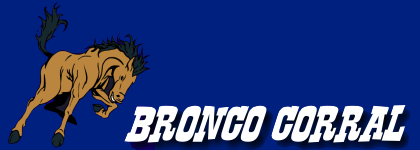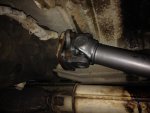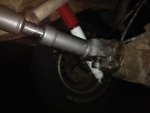Maybe it is an optical illusion, but the shaft in that pic looks like it is bent. It also doesn't look like the u-joints aren't phased properly. But since that is hosted on broncograveyard.com I guess it is their stock pic and not your shaft. If it is the pic of your shaft, um better make sure it really is strait and that the u-joint phasing is correct.
For that type of shaft people say they have seen them mounted either direction and it doesn't make much difference. In my opinion it is best to have the side attached to the center part of the slip joint towards the rear and the sleeve side of the slip joint towards the front. This way, for what it is worth, crap and water is not getting hurled at the point where the sleeve slides over the inner shaft while moving forward.
My shaft is similar looking and it is the right hand side in that picture which I have connected at the transfer case.
I don't think the direction is the problem off hand.
Assuming the shaft is not bent and the phasing is correct
The reason BIIs has the shaft with CV joints is because of the relatively short wheelbase resulting in a fairly steep shaft angle. The CV joints could tolerate that well.
A u-joint type shaft will vary speed as it rotates (unlike with CV joints). The steeper the angle the more it varies. Intrinsically the speed-up/slow-down of the shaft each rotation takes energy/returns energy causing small pulsations, but in practice the mass of the shaft is too small compared to the rest of the mass it is turning to be noticed.
The real problem is that the angles at both end of the shaft need to be the same. This requires the output shaft of the transfer case and input shaft of differential to be parallel in both the vertical and horizontal planes. With the shaft properly phased the rotation speed changes caused by each u-joint at each end will cancel and you will get nice constant rotation at the wheels. If the angles aren't the same (transfer case output shaft/differential input shaft are not parallel) or phasing wrong they won't cancel resulting in the system trying to make your rear wheels and entire vehicle speed up/slow down each shaft rotation. Obviously that isn't going to happen but it wants to and this shows up as vibration.
The steeper the angle of the shaft the more critical this alignment becomes as the rotational speed variation get bigger. There is a point where angles can become too large. This is why Jim mentioned the double cardan type shaft. The angles are already steep on BII, lifting it will make that worse.
I know people who have used the standard two u-joint shafts with lifted BIIs but depending on how much lift that could be pushing it. I also think a double cardan type shaft is more tolerant of angles too but I don't know too much about the ins and outs of that kind of shaft.
A CV drive shaft can cover up many sins since the driveline angles become non-critical and higher angles can be tolerated.
So since you changed from a CV style to the u-joint type, there is no telling how well aligned your driveline was. My guess is that it was off. Now with the U-joint shaft you are noticing it. Or maybe when you lifted it you rotated the rear axle to have it point upwards a little which would definitely mess up angles (although I believe I seen this done when using double cardan type shafts).
Or you just have too steep angles for a u-joint drive shaft after lift.
That is my off hand guess. When I went from CV shaft to the u-joint (since my CV shaft was failing) I picked up a little vibration. I only notice it when accelerating hard in first gear. I don't notice it too much now as I have grown use to it, but it definitely doesn't have the smooth push of the original CV shaft. If I could get a CV shaft in good condition I would go back to CV shaft since I don't do any significant off road driving where the stronger u-joint shaft would be an advantage.
Getting those angles right, if that is what is wrong, may not be so easy. I am not sure how it is done. Mostly rotating rear axle I believe to change vertical (or adding shims under axle mounts I have heard). Hopefully horizontal is correct.
Less pain of the neck things you should check first.
Make sure drive shaft phasing is correct. This is a big one that is easy to check and should be easy to fix.
Make sure shaft isn't bent.
This has some good diagrams and explanation of what is going on
http://jniolon.clubfte.com/drivelinephasing/drivelinephasing.html

